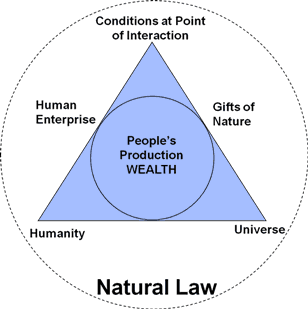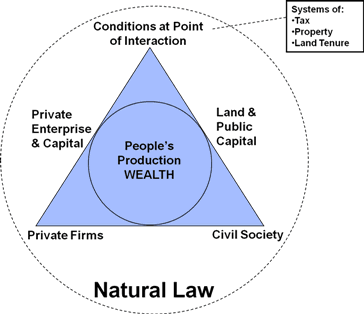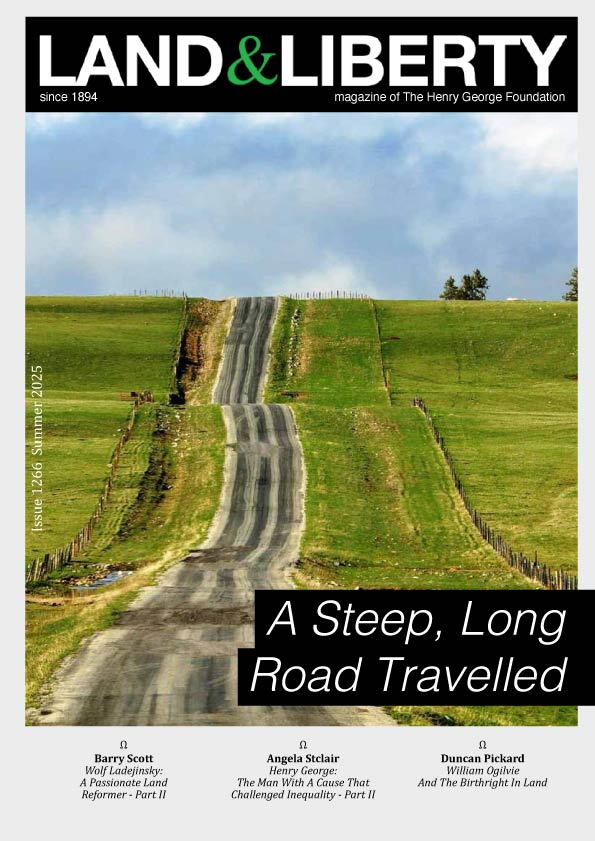Get Updates
Progress without Poverty
Page 2 of 7
Economic Models
I start with an economic model that describes an aspect of natural law that I believe is most relevant to the study of economics.
Figures 1 and 2 demonstrate a fundamental principle that underpins all economic production. The inner circle in each case represents economic production itself. It is styled ‘People’s Production – Wealth’ drawing attention to the fact that all wealth is produced by people. The outer dotted circle represents the all encompassing influence of the laws of nature or Natural Law. It indicates that everything within it is subject to it. In

Figure 1 the lower two points of the triangle represents the human and non human players in the productive process whilst in Figure 2 they represent the individual producer and society respectively. The base line in each case indicates the existence of a direct relationship and influence between them. Each of the two side lines of the triangle indicates the economically significant aspect of the respective players’ nature. The apex of the triangle indicates the importance of the conditions that exist where operation of these two natures interact. The point of showing the influence of natural law in this way is to note that whatever conditions prevail at the point of interaction, the basic model, and the relationship between the players, remains unchanged. Thus the model may be seen to be ‘true’ everywhere and at all times where ‘Humanity’ and the ‘Universe’ are the players as in the case represented by Figure.1. Similarly the model is always ‘true’ in the more limited, but important, case represented by Figure 2 where wealth is the product of Private Firms operating within the context of Civil Society.
In each case we may note the importance of human enterprise to the active side. This includes all human labour, skill, talents, knowledge, will etc. Similarly we may note the importance of Land on the passive side. In Figure 1 this is included in the term Gifts of Nature emphasising the importance of all that is given to mankind and that to which he may ‘add value’ by his enterprise and endeavour, and without which, he cannot exist.
 In Figure 2 the term Land is made more explicit and we see the appearance of the economic term ‘Capital’. In fact capital is not shown explicitly in Figure 1 since it is included in the inner circle denoting ‘People’s Production – Wealth’, capital being that part of wealth that is used to facilitate the production of more wealth. This makes clear the important distinction between Land and Capital. Land is a gift of nature and is not man made, capital is always man made. Capital, for the purposes of economic analysis, is thus not to be regarded as a ‘Primary Factor of Production’ – it is itself a product. It is however a critical factor in all economic societies and is reflected in Figure 2 where its ability to enhance, both the human enterprise of the firm, and the productive potential of society and the land, is recognised.
In Figure 2 the term Land is made more explicit and we see the appearance of the economic term ‘Capital’. In fact capital is not shown explicitly in Figure 1 since it is included in the inner circle denoting ‘People’s Production – Wealth’, capital being that part of wealth that is used to facilitate the production of more wealth. This makes clear the important distinction between Land and Capital. Land is a gift of nature and is not man made, capital is always man made. Capital, for the purposes of economic analysis, is thus not to be regarded as a ‘Primary Factor of Production’ – it is itself a product. It is however a critical factor in all economic societies and is reflected in Figure 2 where its ability to enhance, both the human enterprise of the firm, and the productive potential of society and the land, is recognised.
The productive process itself is shown to consist of the interaction of two primary factors (labour and land) both assisted by capital and society. In a settled trading economy such as we have today the benefits of society are, like the land, intimately associated with location. Not only does society provide a framework for law and order but also provides a range of services and protections that vary in degree and value with their location. Two key and obvious facts, frequently overlooked, show themselves here.
First – no two people (or firms) can occupy the same location at the same time; occupation is invariably ‘exclusive’!
Second – no two locations are identical – there are always differences. Arising from the first it is essential for a civilised and ordered society to adopt a means by which exclusive occupation of locations may be allocated to particular individuals and firms. This needs to be in a manner that provides each with security of tenure suited to the nature of their activity. Arising from the second basic fact is that the occupants of any location will enjoy advantages and disadvantages compared with their fellows who occupy other locations. Whilst the degree of the differences may be slight or great – differences there will always be.
With these two immutable facts in mind we may proceed to show first how production or value added is affected by differences in location advantage.
Donate Today
Bank Transfer
DonateHelp us minimise transaction fees and administrative costs by donating via bank transfer.
PayPal
To Gift Aid your donation, please request a Gift Aid Declaration Form >

